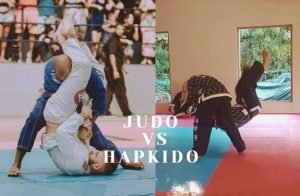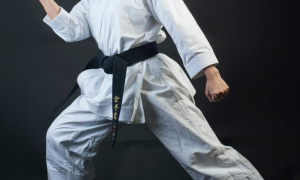
Goju-Ryu and Uechi-Ryu are two influential styles of traditional Okinawan karate. In this article, we will explore questions like “Is Uechi-Ryu effective?” and “Is Goju-Ryu effective?” by examining the origins, philosophies, techniques, and real-world effectiveness of these two karate styles. Understanding their differences and similarities can provide insight for martial artists considering Goju-Ryu vs Uechi-Ryu. We will analyze if these styles are offensively or defensively oriented, their inclusion of ground fighting and grappling, and their approaches to sparring and throws. By addressing effectiveness for self-defense, this article aims to educate readers on choosing between Goju-Ryu and Uechi-Ryu training.
Table of Contents
Toggle![]()
Understanding Goju-Ryu and Uechi-Ryu
To better comprehend the diversity between Goju-Ryu and Uechi-Ryu, let’s take a closer look at their origins, founders, and core philosophies.
Goju-Ryu History and Philosophy
- Founded in Okinawa during the 1930s by martial artist Chojun Miyagi.
- Combines hard “go” techniques like straight punches with soft “ju” techniques like circular blocks.
- Influenced by traditional Okinawan karate and Southern Chinese martial arts.
- Emphasizes balance, flexibility, strength, and proper breathing.
Uechi-Ryu History and Principles
- Introduced to Okinawa in the 1920s by Kanbun Uechi after training in China.
- Based on Pangai-noon, a Chinese martial art focused on circular blocks and strikes.
- Stresses character development, conditioning, and discipline.
- Focuses on controlling muscles and maximizing power through natural body movements.
Both styles have influenced many other forms of karate and contributed greatly to the spread of Okinawan martial arts worldwide. Their training methods and applications make them well-suited for self-defense.
![]()
Goju-Ryu vs Uechi-Ryu: Techniques and Training Methods
The technical curriculum and training methods used in Goju-Ryu and Uechi-Ryu differ significantly:
| Goju-Ryu | Uechi-Ryu |
|---|---|
| Linear punches, spear hands, palm strikes | Circular blocks and strikes |
| Strong, stable stances | Low stances with short steps |
| Emphasis on bone conditioning | Muscle control through sanchin exercises |
| Extensive hojo undo for strength | Total body unity and coordination |
| Kata like sanchin, saifa and seiyunchin | Notable kata include Sanchin, Seisan and Kanchin |
Goju-Ryu utilizes more hand techniques executed from rooted stances. Hojo undo tools are used to toughen limbs and grip. The signature Goju-Ryu kata sanchin strengthens legs and instills proper form.
Uechi-Ryu is recognized by its unique circular open hand blocks, finger strikes, and tightly coiled stances. Intense sanchin practice builds muscles and proper structure. Seisan and Kanchin kata teach fluidity between blocks and counters.
Goju-Ryu vs Uechi-Ryu: Effectiveness in Street Fights
An important consideration for martial artists is whether a style can hold up in street fights and self-defense situations.
Goju-Ryu is highly effective for real-world application due to its balance of offense and defense. Linear punches provide knockdown power while circular blocks offer protection from all angles. Goju-Ryu experts like Morio Higaonna have demonstrated its effectiveness against other styles. The style has been embraced by many MMA fighters and bouncers for its simplicity and pragmatism.
Uechi-Ryu is also well-suited for street self-defense. Its emphasis on total body power and speed generates tremendous striking force. Uechi’s circular blocks can quickly deflect regular punches. Proponents argue it takes less training than other arts to gain proficiency in its natural techniques. Even against boxers, Uechi grandmasters have proven victorious in challenge matches.
Is Goju-Ryu Effective?
- Goju-Ryu is highly effective due to its balance of strong offensive and defensive techniques.
- Its training prepares practitioners to both block attacks and counter-strike decisively.
- Goju-Ryu experts like Morio Higaonna have proven its skills against other styles in challenge matches.
- Many modern MMA champions and street combatants cross-train in Goju-Ryu for its practicality.
Is Uechi-Ryu Effectivene?
- Uechi-Ryu is very applicable for self-defense due to its emphasis on natural body mechanics and power.
- Circular blocks allow you to deflect strikes from multiple angles.
- Conditioning sharpens reflexes and one-strike stopping power.
- Notable Uechi-Ryu masters like George Mattson demonstrated its advantages in publicized fights against boxers.
- Law enforcement officers have adopted Uechi-Ryu for its simplicity and direct techniques.
![]()
Offensive vs Defensive Nature
Martial arts can be categorized based on whether they focus more on offensive or defensive techniques. So where do Goju-Ryu and Uechi-Ryu fall in this spectrum?
Goju-Ryu seeks to achieve harmony between solid attacking and blocking. Its straight punches and kicks provide penetrative power, while circular blocks allow protection from multiple angles. Neither offense nor defense is explicitly prioritized over the other. Proper Goju-Ryu training aims to make both offensive strikes and defensive movements equally instinctual.
Uechi-Ryu also comprises both offensive strikes and defensive techniques in equal measure. Its unique finger strikes target vital points while circular blocks deflect incoming attacks from any angle. Uechi-Ryu teaches students to counter-attack immediately after defending, neither fully committing to offense or defense alone. The style blends both concepts fluidly.
Goju-Ryu vs Uechi-Ryu: Ground Fighting, Sparring, and Grappling
Here is a comparative look at how Goju-Ryu and Uechi-Ryu incorporate ground fighting, sparring, and grappling:
| Goju-Ryu | Uechi-Ryu |
|---|---|
| Minimal ground fighting emphasis | Very limited ground fighting |
| Utilizes sparring with protective gear | Sparring done without gear |
| Limited grabs, sweeps and takedowns | Minimal grappling incorporated |
| Prioritizes strike proficiency | Focuses heavily on kata practice |
Neither style contains extensive ground work or grappling compared to arts like Judo or Brazilian Jiu-Jitsu. They concentrate mainly on developing proficient standing techniques. Sparring is done to test skills, but with higher injury risk in Uechi-Ryu. Some Goju schools integrate more grappling than others. Overall, both styles are foremost focused on precision striking and blocking.
![]()
Throws and Takedowns
In addition to strikes, some martial arts teach throws and takedowns. Here’s how each style approaches these:
Throws and Takedowns in Goju-Ryu
- Goju-Ryu does incorporate some throws, sweeps and takedowns within its curriculum.
- These are not a primary focus but can be applied situationally for self-defense.
- Examples include foot sweeps to disrupt balance and hip throws like ogoshi.
- Such techniques may be taught more extensively in some Goju-Ryu schools.
Role of Throws in Uechi-Ryu
- Traditional Uechi-Ryu has very limited throw techniques integrated into its system.
- Certain schools may incorporate basic trips or takedowns.
- The style generally prioritizes striking, blocking, and stance training over throws.
- Throws are viewed as supplementary rather than essential techniques.
![]()
Conclusion
While Goju-Ryu and Uechi-Ryu share a common Okinawan heritage, they take distinct approaches in their principles, techniques, and tactics. Both possess advantages for self-defense and have retained their relevance and influence in the modern era. Martial artists can benefit greatly from studying these traditional styles, either individually or in combination. Their depth provides a lifetime’s worth of knowledge and skill


